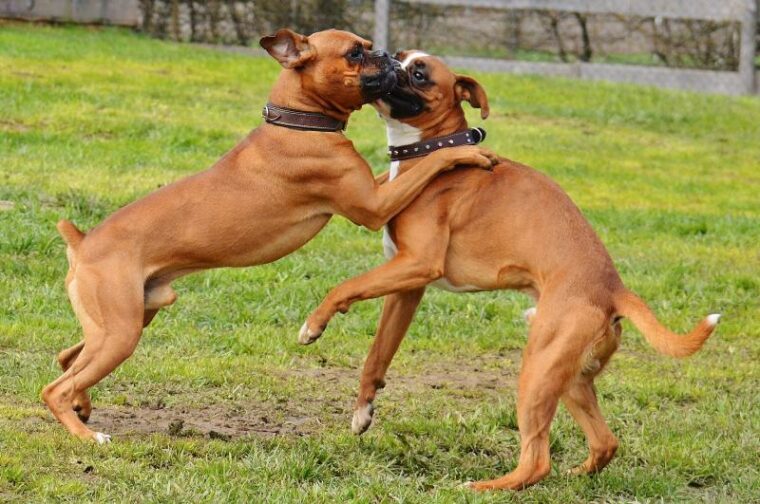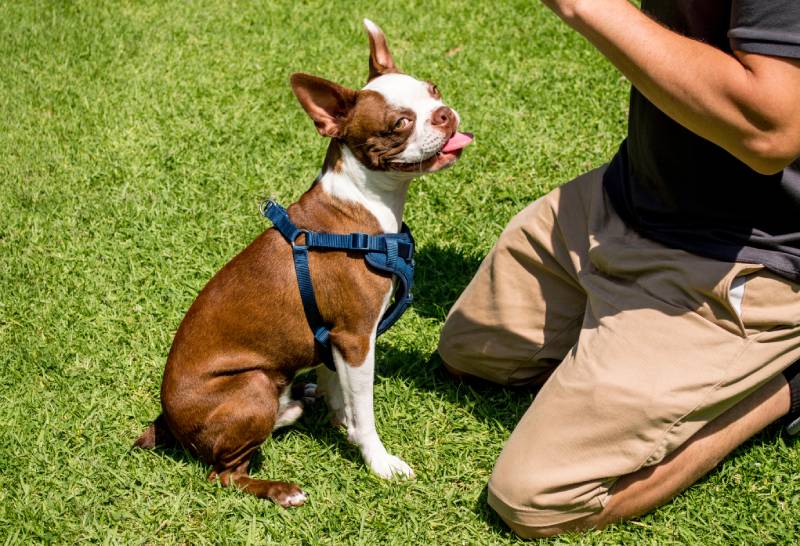
In the canine world, social interaction and hierarchical rules can be a little bit different and more complicated than for us humans. Dogs each have their own unique personalities but are instinctively social animals. In a group of dogs with different personalities and temperaments, they may not always get along with each other. Some dogs can either be solitary, and energetic and even enjoy playing with other dogs. Unfortunately, some dogs can be bullies as well.
Nobody likes bullies, but if you find your dog being pushy, inappropriate, or exhibiting unnecessary aggressive behaviors toward other dogs, you should know what to do to correct these behaviors. Keep reading for a step-by-step guide for dealing with your dog being a bully.
The Step-by-Step Guide on What To Do if Your Dog is Bullying Other Dogs
1. Identify and Recognize Bullying Behavior
The first step in solving a problem is to identify it. As dog parents, it is our responsibility to recognize any inappropriate behaviors—especially if they are affecting other dogs. Bullying behaviors are not always exhibited through aggression, which causes most dog owners to mistake these behaviors as playfulness.
Common signs and bullying characteristics include:
Many of the behaviors can be easily mistaken as harmless play, but bullying can be suspected based on how often your dog exhibits these behaviors, as well as how other dogs respond to them. It should also be noted whether they exhibit these behaviors to only one particular dog, smaller dogs, or all dogs they meet.
2. Intervene as Necessary

After identifying and recognizing your dog’s bullying behaviors and when they exhibit them, it is important to act and correct them immediately. When your dog exhibits bullying behavior, they must be interrupted to redirect their focus. Your dog can be trained to respond to positive interrupters, such as a command or loud sound that tells them to immediately stop and attend to you.
Time outs can also be used to stop any bullying interaction from escalating. Training your dog to respond to negative markers, such as “stop”, can help in creating the association between the undesired behavior and the stopping of their playtime.
With repetition of positive interrupters and negative markers, your dog will eventually recognize unwanted behaviors and act on them. Because emotions and excitability are high, remember to avoid physically intervening when correcting bullying behaviors, as this may put you at risk of getting bit.
An important note to remember is that all dogs are different with varying personalities, temperaments, and limitations. As dog parents, we must be able to familiarize ourselves with what works for our dog and what does doesn’t.
3. Reward Good Behavior
In addition to intervening as necessary, providing positive reinforcement and rewards can help reduce your dog’s bullying behaviors. Giving rewards like verbal praise and treats can promote good behavior and minimize unwanted behaviors. Proper timing of providing rewards is also vital and can help in eliminating bullying behaviors.
4. Provide Consistent Training

Even when they are not exhibiting bullying behaviors, it is important to promote good manners and behavior at home—with other people, and with other dogs. Continuous providing of positive reinforcement, positive interrupters, and negative markers can help train your dog to behave appropriately during social situations and minimize the risk of exhibiting bullying and other unwanted behaviors.
Professional help can also be employed for your dog’s training. Professional dog trainers can provide training to facilitate healthy behaviors, as well as training tips, advice, and instruction on what to do as their pet owners.
5. Provide Ample Stimulation
If dogs do not receive the proper mental and physical stimulation they need, social situations may get them too excited and overly stimulated, causing them to exhibit bullying behaviors. Regular exercise and playtime with your dog can help provide the stimulation they need to prevent over-excitability during social interactions, while also providing multiple health benefits.
Why Do Dogs Become Bullies?
There are various explanations for dogs exhibiting bullying behaviors. A common argument can be their lack of socialization at a young age. Dogs who exhibit bullying tendencies are said to lack the opportunity to learn proper social etiquette from other dogs. Both acceptable and undesired behaviors are normally learned by interacting with older dogs through modelling, as well as receiving signals from older dogs that certain behaviors are unacceptable, such as growling or pushing.
A show of dominance can also be considered a cause of bullying, and must be immediately corrected once identified to prevent any further escalation. Genetics is also considered a factor as to why dogs can become bullies.

Tips on How to Prevent Bullying Behavior
Addressing your dog’s bullying behaviors is one thing, but preventing the behavior entirely is another. Early socialization and training good manners is known to be the gold standard in promoting proper behavior. Higher success rates are seen when younger puppies are exposed to different social situations, compared to older dogs. Similarly, undesirable behaviors are also more easily corrected if done at a younger age.
Spaying and neutering your dogs can help in preventing or minimizing unwanted bullying behaviors, as it lowers hormone levels. This would reduce the likelihood of aggressive behaviors and bullying.
While your dog is learning to correct their bullying behavior, it would also be best to choose their playmates. Controlling who your dog interacts with can help speed up the learning process. This also makes correcting behaviors much easier compared to the overstimulation they can experience if placed in a uncontrolled situation with multiple playmates—such as a dog park.
Conclusion
If your dog is bullying other dogs, it is important to address the behavior immediately. This may involve seeking professional help. It is important to remain calm and patient, as punishing or yelling at your dog may only escalate the situation. By addressing the problem early on, you can help your dog learn appropriate social behavior and prevent any potential harm to other animals.
Featured Image Credit: Alexa, Pixabay








